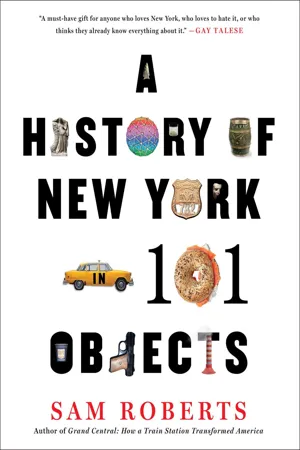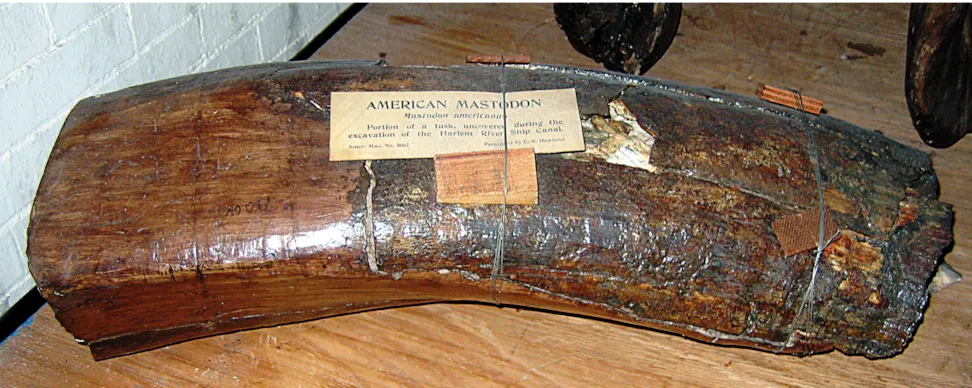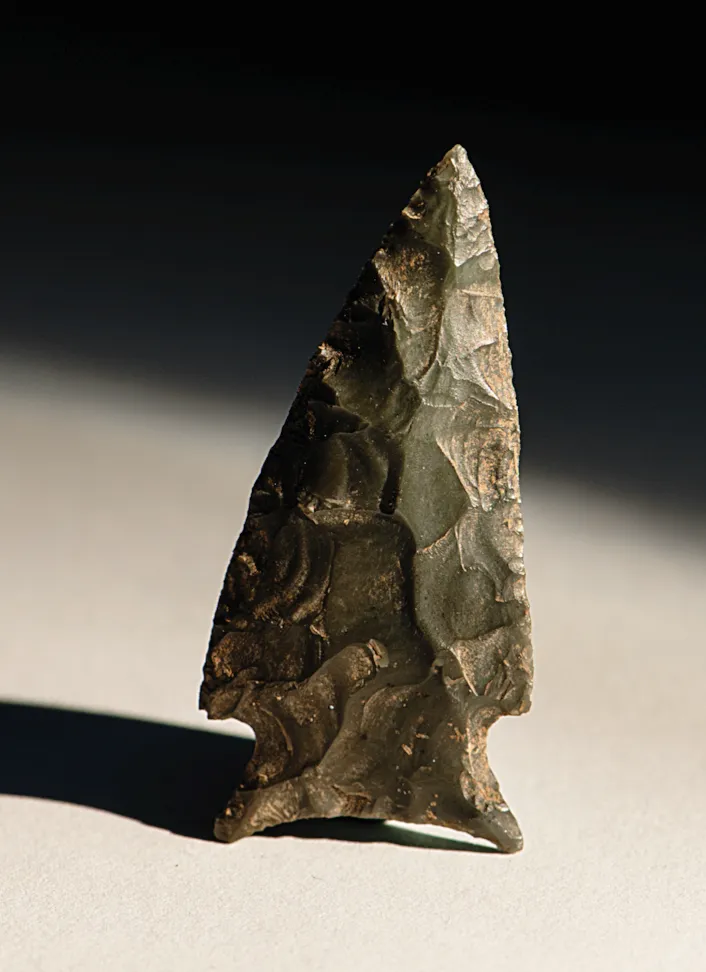![]()
● 1 ●
Fordham Gneiss
Where the Skyscrapers Are
Dense, dark green to black, banded, grainy-textured, it punctuates the unseen underbelly of Manhattan. It was formed hundreds of millions of years ago in a crucible of immense heat and pressure, a tectonic upheaval as volcanoes erupted and the continental plates of Pangaea, the supercontinent, ground against each other. They divided, creating a vast gulf that would separate the Eastern Seaboard from North Africa. It is a rock. It is an island.
• • •
Manhattan is a geologist’s dream. But sophisticated on-site analysis of what lies beneath the surface is a relatively recent phenomenon. Construction of Water Tunnel No. 3, as deep as six hundred feet below street level, the Second Avenue Subway, the Flushing Line Subway Extension, and the Long Island Rail Road’s East Side Access project to Grand Central Terminal under Park Avenue opened a basement window for geologists to confirm their vision of how Manhattan was formed and why skyscrapers sprouted downtown and in midtown but not in between.
Depending on where you live in Manhattan, you can’t honestly say it’s not your fault. What geologists found was a wide variety of metamorphic rock—formed as tectonic plates collided—and distinct geological fault lines along Dyckman Street, 125th Street, Morningside Drive, and Canal Street, suggested by water coursing through the paths of least resistance, fractures and fissures that reached across the spine of Manhattan between the East and Hudson Rivers. While Manhattan schist is the best known of the rock formations that form the city’s subbasement, the island is also defined by amphibolite, by Inwood marble farther uptown, and by Fordham gneiss, which predominates in the Bronx, on Roosevelt Island, and on the Lower East Side (and protruding on “C-rock” opposite the Columbia University athletic complex).
Gneiss (pronounced “nice”) dates back a dazzling 1.2 billion years, when earth-shattering continental collisions caused sedimentary rock to recrystallize into contorted black-and-white-banded metamorphic rock. It is the oldest natural New York object. (The oldest objects in New York are 4.6-billion-year-old meteors and 10-billion-year-old stardust—actually, presolar grains in primitive chondrites—at the American Museum of Natural History. The oldest handcrafted object in Manhattan is considered to be the obelisk known as Cleopatra’s Needle, dating from 1450 B.C. and installed in Central Park in 1881.)
The interlayered rock formations belowground are analogous to the intermixed neighborhoods on the surface. The granites are folded into tunnel walls exposed by monstrous rock-boring machines. The undulating formations are the bedrock that defines Manhattan’s skyline. In midtown, bedrock is just below the asphalt. To build the World Trade Center, seventy-five feet of fill, glacial till, and muck had to be excavated until bedrock was reached. In between downtown and midtown, the bedrock surface dips into a deeper trough and the ground is relatively squishy, which means that a century or so ago, building a skyscraper there would have been too challenging for contemporary engineering. Today, while it may be prohibitively expensive, such construction is technologically possible. Good rocks, geologists like to say, make good foundations and good tunnels.
Underground Manhattan is laced with unseen, taken-for-granted tunnels, the latest of which is the East Side Access, 170 feet below Park Avenue. It stretches from the East Sixty-Third Street tunnel under the East River, which it shares with the subway from Queens, and terminates at East Thirty-Sixth Street, just below the Union League Club. (A Manhattan portion of the sixty-mile-long third water tunnel, which has been under construction for four decades and is scheduled for completion around 2020, opened in 2013; the Long Island Rail Road’s direct East Side Access is now expected to start around 2020.)
Legally, landlords own the land beneath their property to the center of the earth, so tunnels require easements, which, in the case of government agencies, can be obtained through negotiation or by exercising the right of eminent domain. An advance team of geologists mines the excavations to verify topographical details of the original shoreline and underground water courses still derived from the pre-development 1865 map of Egbert Viele (a civil engineer and congressman), to adjust engineering specifications to the conditions that are discovered, and to leave a geological record for posterity. Finding amphibolite and similar rock formations migrating like baked taffy—one geologist likened the pattern to a Charleston Chew—in both Manhattan and Morocco provides evidence substantiating Alfred Wegener’s once ridiculed theory of continental drift.
![]()
● 2 ●
Mastodon Tusk
Before Skyscraper National Park
The first recorded discovery of mastodon remains in the city was in 1858, during the digging of the Baisley Pond reservoir in Queens, although unsubstantiated reports date earlier (including a large bone found ten feet below the basement of a house at Broadway near Franklin Street in 1840). In 1885, Elisha Howland, principal of a grammar school on West 128th Street, turned up with a fifteen-inch lower extremity of a mastodon tusk found buried in peat by ditch diggers near the Presbyterian church in Inwood in upper Manhattan.
That same year, excavations for the Harlem Ship Canal produced a three-foot-long mastodon or mammoth tusk sixteen feet below mean water level at the eastern end of Dyckman’s Creek and the Harlem River. The dig was in a salt meadow under sod, silt, peat, sandy clay. The tusk was embedded with the butt end down. “It seems probable,” wrote R. P. Whitfield of the American Museum of Natural History, “that the animal to which the tusk once belonged either died near the spot, or by some accidental injury had it broken from its socket near where it was found.” By the time laborers on the canal unearthed a yard-long mastodon tusk in 1891, it must have seemed commonplace. The find merited only a paragraph in The New York Times.
Evidence that mastodons once roamed what is now Manhattan may still be found in an unusual form: honey locust trees, which survive on many streets. They are descendants of a species that paleoecologists say developed prickly spikes to deter mastodons from swallowing leaves and branches in one giant mouthful.
Eric Sanderson, an ecologist with the Wildlife Conservation Society in the Bronx, has written that as recently as four centuries ago, Manhattan had more separate ecological communities than Yellowstone, more native plant species than Yosemite, and more birds than the Great Smoky Mountains.
“If Mannahatta [as he calls it] existed today as it did then, it would be a national park,” Sanderson says. “It would be the crowning glory of American National Parks.”
![]()
● 3 ●
Arrowhead
The Better to Shoot You
Humans ventured to New York at the end of the last ice age, and stone projectiles dated back about nine thousand years have been found near Port Mobil on Staten Island. Scattered prehistoric cultural artifacts—including hearths and crude spear points—found on a bluff overlooking Raritan Bay in Tottenville, Staten Island, attest to the presence of Paleo-Indians there at least eight thousand years ago. (The mastodons might have still been present.) The Iroquois arrived around the ninth century from the Appalachian region, and Algonquin tribes from Ontario and upstate New York. Their cultures, as Europeans would discover them, were largely developed by around the twelfth century. A New York State Historical Association study concluded that the Native Americans established “a complex and elaborate native economy that included hunting, gathering, manufacturing and farming.” A mosaic of tribes, nations, languages, and political associations existed before what amounted to a colonial invasion.
Most local Indians were related to the Lenape—the “real people,” by one definition. A plaque placed at the tip of Manhattan by the Smithsonian’s National Museum of the American Indian describes the island paradise where they grew corn, beans, and squash: “Following the round of the seasons, the first people planted, hunted and fished in the spring. In the warmest season when the smell of wild flowers perfumed the air, they traveled for trade and adventure. . . . When the leaves changed color, the villagers gathered to harvest, hunt and collect food for the winter. During the cold moons and long nights they made objects for trade, repaired tools, told lesson stories and celebrated festivals.”
A history edited by Hubert H. Bancroft early in the twentieth century recalled that the arriving Dutch were the beneficiaries of a war between the Five Nations of the Iroquois and the Algonquin, who were armed by the French in Canada. The Iroquois viewed the Dutch as a gun-toting potential ally. Bancroft’s history concluded, “Though jealous by nature, and given to suspicion, the Indians exhibited none of these feelings towards the new-comers, whose numbers were too few even to protect themselves or to inflict injury on others. On the contrary, they courted their friendship, for through them they shrewdly calculated on being placed in a condition to cope with the foe, or to obtain that bloody triumph for which they thirsted.”
The Staten Island site, known as Burial Ridge, was used as a graveyard thousands of years later by the Munsee and other branches of the Lenape, who witnessed Henry Hudson’s approach in 1609. Evidence of later contact with Europeans was excavated, along with arrowheads made of bone, antler, stone, and metal.
Giovanni da Verrazano, an Italian sailing in 1524 for the king of France, reported that natives “clothed with the feathers of birds of various colors” approached his party “joyfully, utte...



